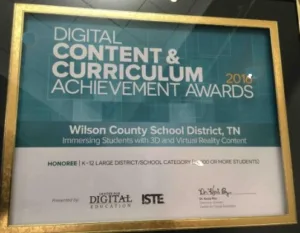There are a lot of good things happening with educational 3D across the country, yet I find that most of the great stories about 3D in classrooms somehow seem to fly under the radar.
Yes, good things are in fact happening, but often no one knows about them. That’s because educators rarely toot their own horn; it’s also because the education industry is highly isolated and successful programs are often geographically pigeonholed. Rarely do successes get the broad recognition they deserve. It’s for that reason that I continue our series on 3D School Success Stories here.
Some pundits feel that 3D in education has peaked. But it didn’t seem that way at all at ISTE 2016, where one 3D project in a mid-sized school district won a prestigious national award. (The ISTE 2016 educational conference held just this summer, with over 16,000 in attendance hailing from 76 countries, is the largest ed-tech conference held in the U.S.) Located just east of Nashville (TN), the respected Wilson County Schools were honored with one of ISTE’s highest awards, the ISTE Digital Content and Curriculum Achievement Award for 2016, for “Immersing students with 3D and Virtual Reality Content.”
More than a year ago, Wilson County teachers and administrators started using both 3D visualization/simulation software and 3D virtual reality tools in their STEM instruction. Their goal was purposeful: to use 3D visualization to address some of the difficult and more abstract concepts students struggle with in their STEM lessons.
According to Nina Williams, one of the project leaders for this award-winning effort, “We implemented the program within the four high schools in our district, grades 9-12. Our focus areas primarily included the Chemistry and Biology, as well as some of our CTE courses in Diagnostic Medicine, Anatomy, and Physiology.” They also used the 3D visualization with their AP Psychology classes. Commenting specifically on the AP psychology implementation, Williams offered: “It went extremely well. Students reported that the 3D visualizations aided in their overall comprehension of the biological content for Psychology. Students were able to explore the 3D content on their own and then as a culmination assessment, students created their own 3D videos complete with audio and questions for their peers to answer. Students viewed the created 3D videos and answered corresponding questions for grades.”
“We were delighted to see how engaged and fascinated the students were when first introduced to the 3D software”, gleamed Williams. “They consistently reported how the program enhanced their understanding of core content. It was impressive to see how easily students navigated through the program and even used its content to create their own 3D videos to be viewed through VR headsets.” (The 3D visualization/simulation software used by Wilson County Schools was the well-known Sensavis product, The 3D Classroom.)
This last paragraph highlights one of the surprises that came out of this effort—the unexpected utilization of VR headgear. “The Sensavis 3D content was also responsible for leading us into the VR world for instructional enhancement”, explained Williams. “After seeing how students responded to the 3D visualizations we invited Google Expeditions to our District to pilot their new Virtual Fieldtrip app. Students, teachers, and administrators alike were captivated with the VR field trips. Our District now has a classroom set and teachers across all levels are using it as a tool for instructional engagement for our students.” And thus students began converting their 3D Sensavis lessons to VR format for viewing.
The unique storyline here is that the Wilson County Schools found themselves combining the Sensavis 3D visualizations, the existing computer labs in their four high schools, and Google Cardboard VR headgear in a creative instructional mashup that earned the ISTE award committee’s acclaim. -Len Scrogan



